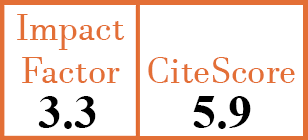Full Papers
Retention rate and predictors of discontinuation for secukinumab treatment: real-life data in a cohort of patients with spondyloarthritis
E. Bellis1, M. Gatto2, G. Crepaldi3, V. Data4, C. Lomater5, E.M. Marucco6, S. Perrone7, M. Saracco8, A. Iagnocco9
- Academic Rheumatology Centre, Department of Clinical and Biological Sciences, University of Turin, AO Mauriziano di Torino, Turin, Italy.
- Academic Rheumatology Centre, Department of Clinical and Biological Sciences, University of Turin, AO Mauriziano di Torino, Turin, Italy.
- Academic Rheumatology Centre, Department of Clinical and Biological Sciences, University of Turin, AO Mauriziano di Torino, Turin, Italy.
- Academic Rheumatology Centre, Department of Clinical and Biological Sciences, University of Turin, AO Mauriziano di Torino, Turin, Italy.
- Academic Rheumatology Centre, Department of Clinical and Biological Sciences, University of Turin, AO Mauriziano di Torino, Turin, Italy.
- Academic Rheumatology Centre, Department of Clinical and Biological Sciences, University of Turin, AO Mauriziano di Torino, Turin, Italy.
- Academic Rheumatology Centre, Department of Clinical and Biological Sciences, University of Turin, AO Mauriziano di Torino, Turin, Italy.
- Academic Rheumatology Centre, Department of Clinical and Biological Sciences, University of Turin, AO Mauriziano di Torino, Turin, Italy.
- Academic Rheumatology Centre, Department of Clinical and Biological Sciences, University of Turin, AO Mauriziano di Torino, Turin, Italy. annamaria.iagnocco@unito.it
CER18338
2025 Vol.43, N°9
PI 1561, PF 1567
Full Papers
Free to view
(click on article PDF icon to read the article)
PMID: 40658475 [PubMed]
Received: 14/11/2024
Accepted : 10/03/2025
In Press: 04/07/2025
Published: 18/09/2025
Abstract
OBJECTIVES:
This study evaluated the real-world retention rate and predictors of discontinuation for secukinumab therapy in patients with spondyloarthritis (SpA).
METHODS:
This observational, retrospective cohort study included SpA patients treated with secukinumab at a referral centre. Baseline demographic and clinical data were recorded, covering comorbidities, prior biologic/targeted synthetic therapies, and disease duration. Secukinumab retention rates were analysed at 12 months and at the end of the study (last observation or discontinuation). Drug retention rate (DRR) was assessed using time-to-discontinuation, with log-rank testing for comparisons. Cox proportional hazards regression models identified baseline predictors of discontinuation.
RESULTS:
A total of 178 patients (64.6% female) were included. The overall DRR for secukinumab was 64%, with the highest retention rate of 78% at 1 year. Discontinuation reasons included secondary inefficacy (57.8%), primary inefficacy (25%), and adverse events (17.2%), with infections being the most common adverse event. Higher body mass index (BMI) (HR 1.07, 95% CI: 1.02–1.12, p=0.010) and previous treatments (HR 1.34, 95% CI: 1.03–1.73, p=0.030) predicted long-term discontinuation. For 12-month discontinuation, peripheral phenotype (HR 4.28, 95% CI: 1.26–14.48, p=0.019) and prior biologic/targeted synthetic therapies (HR 1.76, 95% CI: 1.24–2.51, p=0.002) were predictors, while axial involvement was protective (HR 0.37, 95% CI: 0.17–0.83, p=0.016).
CONCLUSIONS:
Secukinumab demonstrates sustained effectiveness in SpA patients, with a significant proportion maintaining therapy over time. Retention is influenced by BMI, prior treatments, and disease phenotype, suggesting that outcomes may be optimised through tailored patient selection and early intervention.



